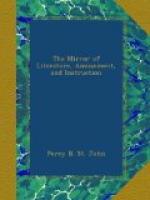“And Katerfelto, with his hair on
end,
At his own wonders wondering for his bread,”
Task—Winter Evening.
All that I could discover about him, I found accidentally in a pamphlet on Quackery, published in 1805, at Kingston-upon-Hull. In a note to that little work, I am informed that Dr. Katerfelto practised on the people of London in the influenza of 1782; that he added to his nostrum the fascinations of hocus pocus; and that among other philosophical apparatus, he employed the services of some extraordinary black cats, with which he astonished the ignorant, and confounded the vulgar. But he was not, it seems, so successful in his practice when out of London: not long before his death, he was committed by the Mayor of Shrewsbury to the common House of Correction in that town, as a vagrant and impostor. When or how he died does not appear.
Cowper, when he mentions the name of Katerfelto, in the Task, in alluding to the advertisements of the London newspapers—and probably wrote the passage in the year 1782. The Task was published complete in 1785.
Whoever has easy access to the newspapers of 1782 or thereabout (as I, at this moment have not) will most probably discover some amusing particulars about this Doctor, that may attract your readers, few of whom will be more gratified than
Great Russell-st.
W.C.
* * * * *
THE CHEROOT.
(To the Editor.)
In page 429, vol. xvi. of your amusing Miscellany, the Cheroot is called a China Cigar. The writer, if he had given himself the trouble to inquire of any person who had ever been in that country, would have ascertained that there is no such thing as a Cheroot manufactured in China; and what are called Cigars there are nothing more than a small quantity of very fine cut yellowish tobacco, wrapped up in white paper, and about two inches or rather more in length. These, the Chinese sometimes smoke, but generally prefer a shallow cupped pipe of composition metal, of which copper is the principal part; to which a long whanghee or small black bamboo is attached, as a stem or stalk, sometimes more than a yard in length, and tipped with an ivory tube or mouthpiece. They generally carry a piece of joss-stick or slow-match with them, and a flint, steel, and punk; and when they are inclined to smoke, they strike fire on apiece of punk, and light the joss-stick, which will continue burning a long while. As their tobacco is very fine and dry, the pipeful seldom takes more than one or two whiffs to consume it, and they emit the smoke through their nostrils in large volumes. In this manner they will smoke more than a dozen pipesfull in a short time. Cigars are generally imported into China by the Americans, or sent from Manilla; and Cheroots by the English and other trading vessels from Bengal or from Madras.




